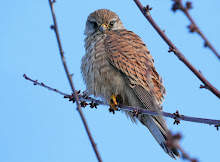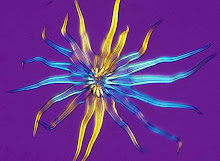
The arrival of spring brings a sudden burst of reproductive growth on the seashore intertidal zone, just as it does in woodlands. The big difference is that on the seashore it's algae - seaweeds - that are switching into reproductive mode, not flowering plants like bluebells. The picture above shows chanelled wrack Pelvetia canaliculata on the shore at Low Newton on the Northumberland coast and ....

.... this is knotted wrack Ascophyllum nodosum. The swollen tips of the channelled wrack and those yellowish egg-shaped objects on the knotted wrack contain the reproductive structures.
Brown
seaweeds in the genus Fucus are common in the intertidal zone. Two
species are visible here - saw wrack Fucus serratus with a saw-tooth
edge to the fronds and bladder wrack F. vesiculosus with smooth frond
edges and paired flotation bladders. In spring they make rapid new growth
and enter their reproductive phase, producing swollen receptacles at the end of
the fronds
The receptacles are covered in large numbers of small
swellings called conceptacles, each of which opens via a minute pore called an ostiole.
This is a transverse section of the conceptacle of a brown
seaweed Fucus sp., viewed under a fluorescence microscope. It has been stained
with a fluorescent dye called anilino-naphthalene-sulphonic acid to reveal the detail in its structure.
This is a section through a receptacle showing two
conceptacles developing inside. This is from a female conceptacle. The
radiating, elongated filament-like structures are sterile hairs (paraphyses)
and the club-shaped structures are oogonia, each of which produces eight eggs
(oospheres)....
......
and here is an egg (oosphere) being liberated from an ostiole into the
surrounding sea water. Inside the conceptacle some oogonia are still dividing to produce oospheres - you can see the cell walls forming (click on the picture for a larger image).
The clusters of small bright yellow structures that you can see above amongst the rounded oospheres are the antheridia that produce the antherozoids - this conceptacle is hermaphrodite, showing that it came from spiral wrack Fucus spiralis; saw wrack and bladder wrack have conceptacles that are either male or female.
When
the conceptacles are mature eggs and vast numbers of swimming male cells
(antherozoids) are liberated into the water of the rising tide - most
prolifically during spring tides - and at high water the eggs are
fertilised, if they are lucky, and carried away by the falling tide. If they're
luckier still the fertilised zygotes attach to a rock and develop into a new
seaweed.
The pictures above and below show fertile fronds of a Fucus species attached to the harbour wall at St.Peter's marina at the mouth of the river Wear in Sunderland at high tide. That calm water will be seething with countless seaweed eggs and antherozoids, engaged in the frantic business of reproduction.
You can find more detailed information on the structure and life cycle of seaweeds here
For soothing movie of seaweeds swaying in the tide click here




















































